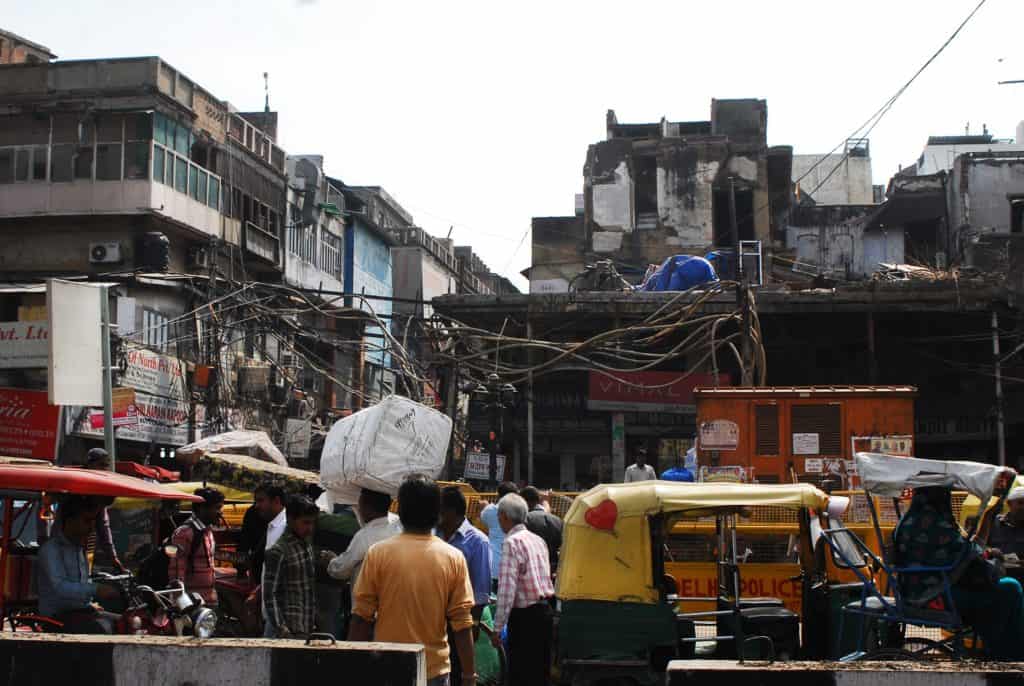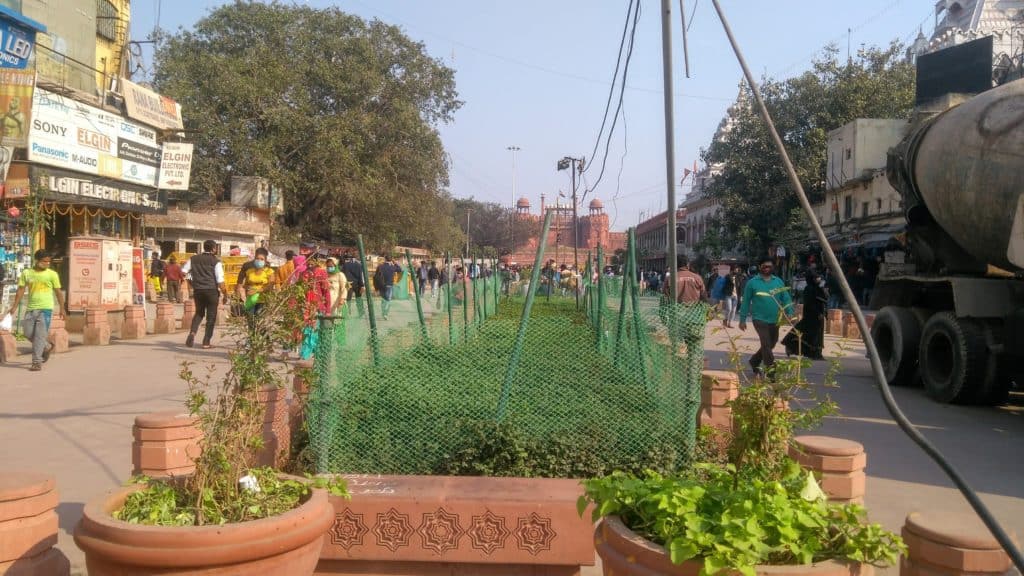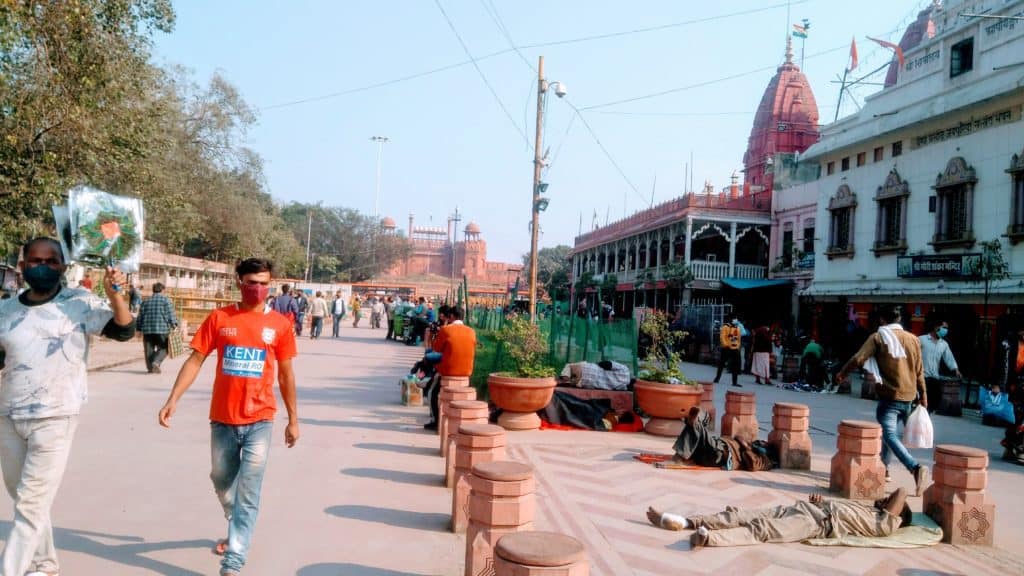The silvery reflection of moonlight on the waterway, lined on both sides with shops and havelis, gave the stretch its name—Chandni Chowk. That was 17th century Shahjanabad, the city built by Mughal emperor Shah Jahan. The water has long receded, but the name remains.
Today’s Chandni Chowk is a far cry from what it had been before the pandemic struck. The few intrepid citizens who ventured to that heritage street in recent weeks were pleasantly surprised and totally thrilled by what they saw. Vloggers, particularly, had a field time capturing the bustling 17th century market in Old Delhi in its Kejriwal-times avatar.

As India unlocked in early May and Delhiites started to venture out to visit the places they had hung out in and places they missed, Chandni Chowk would have been a natural destination for many foodies and shoppers. But with Delhi Metro resuming services only in September, the eclectic wholesale bazar had to wait to fully open up, especially in these days of social distancing.
The redevelopment of the 1.3 km long main road named Chandni Chowk, with the Red Fort looming large at one end, and the humbler Fatehpuri Mosque keeping guard at the other, has totally changed the look of the place. “It doesn’t feel like the same old place, though it has changed for the better” says Aman Kumar, who captured the new-look Chandni Chowk on his camera in end October, days before it was to be formally inaugurated.

The road is steeped in history. The Sheesh Ganj Gurdwara with its glittering golden dome was built in 1783 in memory of the ninth Guru Teg Bahadur who was beheaded at the instance of Aurangzeb in 1675. The landmark State Bank of India building, completed in 1806, is a colonial structure that almost crumbled in 1857, but was declared a heritage building in 2002, when work on its restoration began.
The Central Baptist Church was built in 1814 and the Jain Mandir in 1656; the latter also houses a hospital for birds for a century now. Plus any number of once-beautiful havelis tucked away behind the over 75,000 shops on this road. There are many more in the many lanes and by lanes that branch out, like tributaries off a river. Most shop owners trace their ancestry to the time when Shahjehanabad was built!
A Rs 65-crore project
The present redevelopment makes the road look wider. Gone are the encroachments. There are no rickshaws, e-rickshaws and auto rickshaws zigzagging their way through the heavily congested road. Absent too are the irate owners of swanky cars, impatient cyclists and motorcyclists, jostling for space with pedestrians and human drawn carts laden with tons of everything from fabrics to spices to plastics to steel, and much else.
Instead, today there are only masked walkers on the two-lane red-stoned pedestrian-only stretch divided by a patch of lush green plants, and lots of stool-sized carved red stone pillars and carved red stone benches on tile-floored dividers. The road is flanked by wide pavements, now occupied by vendors selling all kinds of things, like in the past.

Others wanting to take in the sunshine are sprawled on the dividers on a cold, end of November morning. Gone are the dirty, dangerously exposed mesh of electric wires that almost touched the heads of those who had height to boast.
The redevelopment of this market, often claimed to be the largest wholesale bazar in the country, has long been a necessity, with historians, culture and heritage buffs pushing the government to do something, which somehow never took off till two years ago.
The Shahjahanabad Redevelopment Corporation was set up as a special purpose vehicle in 2008 to conserve the enormous cultural heritage contained within the walled city of old Delhi—Delhi 6 to the younger generation after a hit film by that name, after its pin code. The redevelopment of Jama Masjid and Chandni Chowk were two projects highlighted by the corporation.
Work on Chandni Chowk’s redevelopment finally began in December 2018. Of the Rs 65.63 crore earmarked for the project, the biggest chunk of Rs 45.03 crore went towards the works done by the PWD, while the share of the BSES and the DJB was Rs 13.52 crore and Rs 9.06 crore respectively.
The project comprised:
- Redevelopment of the stretch from the Jain Mandir to the Fatehpuri mosque
- Change of water supply pipes, which involved changing the old pipes as well as the layout of the pipes
- Repair and replacement of the existing sewer line by the Delhi Jal Board
- Supply and installation of 23 transformers on the central verge, setting up high-tension and low-tension cables and installing feeder pillars by the power discom BSES
- Building a fire line, footpath and carriageways, and two rows of tree venues besides providing street lighting by the PWD.
A few public toilets are also in the plans, but have yet to be built.
Pedestrians happy, shopowners not so much
While pedestrians are seen happily strolling in the redesigned Chandni Chowk, shopkeepers share mixed reactions.
A leading photographic equipment store owner, not wanting to be identified, pointed out that while the redevelopment does look and feel good, shopkeepers and their customers are facing many difficulties.
“It has been completely pedestrianised, no kind of motorised or non motorised vehicle is allowed except between 11 pm and 6 am,” says the shop owner. “Most shops in this market are wholesalers, who will have to unload, and use galiwalas (coolies) to bring supplies from one of the main roads. That is both inconvenient and costly.”
Their customers who are retailers and buy in bulk too have to spend more to carry their purchase to their car or tempo. “In this market, people are used to parking their vehicles just outside the shop. Others hired carts which are not allowed now. It has also become difficult for the very senior citizens and the handicapped, to visit this place in the absence of rickshaws, e-rickshaws, buses etc.”
Before the road was dug up for restoration, cycle rickshaws and e-rickshaws charged ten rupees to drop off a person from the Red Fort or Chandni Chowk metro stations to anywhere on the road. The Delhi Transport Corporation (DTC)’s small green buses too had a shuttle service from one end of the road to the other, charging five rupees.
And it is not just the shopkeepers who have complaints. Vijay Goel, a BJP leader who has represented the Delhi Sadar constituency once and Chandni Chowk constituency twice in the Lok Sabha, points out that what the government has done is only redevelop the 1.3 km road.
“Without developing the whole of the old city, there is no use developing just one road, Chandni Chowk,” says Goel. “I am in favour of pedestrianising the road. But the problem is when you pedestrianise one road, you leave the whole traffic burden on the other galis, mohallas and small roads.”
Goel in fact had bought an old tumble-down haveli and passionately restored it. Today, his Dharampura Haveli is a beautiful and popular hotel in the heart of Chandni Chowk. “I not only restored the haveli over 6 years, I also developed the four roads surrounding the it,” says Goel. “I had all the wiring done underground, and we pedestrianised one road. I had all the sign boards on this road painted in the same style with the same colour. They are still like that. It is not difficult to do this in the entire area …”
“Without developing the whole of the old city, there is no use developing just one road, Chandni Chowk…when you pedestrianise one road, you leave the whole traffic burden on the other galis, mohallas and small roads.”
Vijay Goel, BJP Leader
A mall too
Goel, who has many times made a strong pitch for the entire Walled City of Delhi being declared a World Heritage City, points out that when tourists from the Chandni Chowk road take to the smaller streets, the ugliness that is being sought to be removed through the redevelopment will hit them hard.
“There is a necessity to develop the whole of the Walled City, and that means revamp of the electricity, the wires, the sewer system, the roads, grills, removal of encroachments, systematic traffic, and includes a cap on the number of rickshaws; you have to prepare a traffic plan too — allowing for one way somewhere, two way elsewhere and pedestrianisation in some places, so that total development happens.”
Goel emphasizes that the main problem in the Walled City are the many unauthorised constructions done with the connivance of MCD officers and police. “Everyday, one or the other beautiful haveli is destroyed by corrupt bureaucrats and greedy builders,” adds Goel. “They can all be restored like I did with the one that I bought. Heritage conservation cannot be complete by merely pedestrianising one road.”
Meanwhile, Chandni Chowk is getting its first mall as part of this redevelopment. A multi-level car parking structure is under construction at the 4.5-acre Gandhi Maidan car park, barely a 100 metres from Gurdwara Seeshganj.
Though not on the main road, this is a parcel of land that sources say nobody thought of for commercial development till three years ago. Named Omaxe Chandni Chowk, a sales rep of this real estate company said it will not only provide parking for about 26000 cars and 81 tourist buses that now park outside the Red Fort, but also connect the two metro stations and have three floors of commercial space.
Designed in the traditional Indian, Moghul and British styles of Chandni Chowk, the mall slated to be completed by July 2022, will be a modern version of the bazaar Shah Jahan built centuries ago.
Centuries will not only coexist, but also now compete in Chandni Chowk.